| Many phases of matter
are characterized by order of some electronic degree of freedom such
as spin (as in the case of spin density waves - SDW), or charge (as
in the case of charge density waves - CDW). Other phases are
characterized by more complicated order parameters that are directly
related to many-body effects (as in the casea of superconductivity).
It is possible to tune between phases with order and without order by
tunning some parameter such as the temperature of the system. These
finite temperature phase transititons have been well studied in the
context of classical critical phenomena. Much less is known by phase
transitions that occur at zero temperature in which quantum
fluctuations play an important role.These quantum phase transitions
(QPT) are responsible for very unusual behavior that cannot be
described within traditional theoretical frameworks. QPT transitions
can be tuned by the application of pressure, magnetic field, or even
chemical modification, that unavoidably introduces disorder in the
material. Disorder can strongly affect QPT because quantum
fluctuations are very sensitive to geometrical constraints. Cold atom
systems, high temperature superconductors, transition metal
dichalcogenides, and heavy fermion materials are example of systems
where QPT are believed to play an important role.
|

